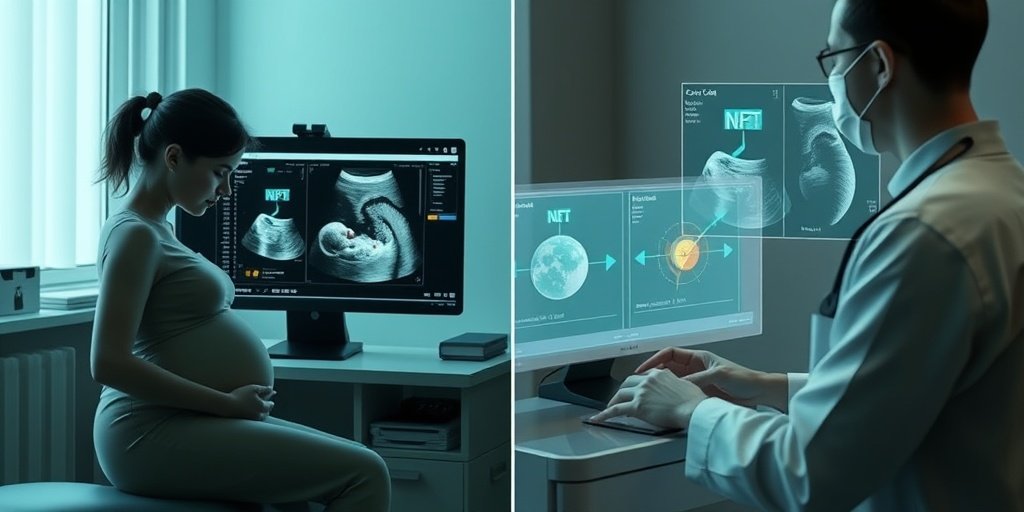⚡ Quick Summary
This study developed a transfer learning model utilizing first-trimester ultrasound images to predict Down syndrome, achieving an impressive accuracy of 98.3%. The model’s performance highlights its potential to enhance early detection and reduce reliance on manual measurements.
🔍 Key Details
- 📊 Dataset: 1,056 images of normal fetuses and 12 images of fetuses with Down syndrome
- 🧩 Features used: Nuchal translucency (NT) and nasal bone (NB) characteristics
- ⚙️ Technology: Transfer learning with AlexNet architecture and Grad-CAM for visualization
- 🏆 Performance: Accuracy 98.3%, AUC 0.98, Sensitivity 89.47%, Specificity 100%
🔑 Key Takeaways
- 🤖 AI-based classification framework enhances the detection of Down syndrome.
- 📈 High accuracy of 98.3% demonstrates the model’s effectiveness.
- 🌟 Grad-CAM visualization provides insights into model decision-making.
- 🔄 Data augmentation techniques improved the training dataset significantly.
- 💡 Early detection can lead to better prenatal care and informed decision-making.
- 🏥 Study conducted at Taiwan J Obstet Gynecol, showcasing local research advancements.
- 🆔 PMID: 41213747 for further reference.

📚 Background
Down syndrome is the most prevalent chromosomal disorder, often identified through increased nuchal translucency (NT) and absent nasal bone (NB) during first-trimester ultrasounds. Traditional methods of detection can be subjective and may not always yield timely results. The integration of artificial intelligence in this domain presents an opportunity to enhance diagnostic accuracy and efficiency.
🗒️ Study
The study aimed to develop a robust transfer learning model for the automated detection of fetuses at high risk for Down syndrome. Utilizing a dataset of 1,056 normal fetal images and 12 images of fetuses diagnosed with Down syndrome, the researchers employed the AlexNet architecture integrated with Grad-CAM to identify critical features in ultrasound images.
📈 Results
The model demonstrated exceptional performance, achieving an accuracy of 98.3% and an AUC of 0.98. The sensitivity and specificity were reported at 89.47% and 100%, respectively. Notably, the model’s decision-making was influenced primarily by the NT and NB regions, as indicated by Grad-CAM visualizations, which provided valuable insights into its diagnostic reasoning.
🌍 Impact and Implications
The implications of this study are profound, as it enhances the early detection of Down syndrome, potentially leading to improved prenatal care and informed parental decision-making. By reducing reliance on manual measurements, this model could streamline the diagnostic process, making it more efficient and accurate. The integration of AI in obstetrics could pave the way for future advancements in prenatal diagnostics and maternal-fetal medicine.
🔮 Conclusion
This study highlights the remarkable potential of transfer learning in the field of prenatal diagnostics. By leveraging AI to analyze first-trimester ultrasound images, healthcare professionals can achieve higher diagnostic accuracy and improve early detection of Down syndrome. The future of prenatal care looks promising with the continued integration of advanced technologies in clinical practice.
💬 Your comments
What are your thoughts on the use of AI in prenatal diagnostics? We would love to hear your opinions! 💬 Leave your thoughts in the comments below or connect with us on social media:
Developing a transfer learning model for the prediction of Down syndrome from first-trimester ultrasound images.
Abstract
OBJECTIVE: Down syndrome is the most common chromosomal disorder, frequently associated with increased nuchal translucency (NT) and an absent nasal bone (NB) during first-trimester ultrasound. This study aims to develop a transfer learning (TL) model for the automated detection of fetuses at high risk for Down syndrome.
MATERIALS AND METHODS: An artificial intelligence (AI)-based classification framework was developed using TL with the AlexNet architecture and integrated with gradient-weighted class activation mapping (Grad-CAM) to automatically detect NT and NB features in first-trimester ultrasound images. The model was trained on a dataset comprising 1056 images of normal fetuses and 12 images of fetuses with Down syndrome. To enhance training consistency and model generalizability, image cropping and class weighting techniques were applied.
RESULTS: To address class imbalance, the 12 Down syndrome images were augmented using rotation, mirroring, and brightness adjustments, resulting in 96 anatomically faithful images. The model achieved excellent performance, with an accuracy of 98.3 %. The area under the receiver operating characteristic curve (AUC) was 0.98, and the sensitivity, specificity, positive predictive value, and negative predictive value were 89.47 %, 100 %, 100 %, and 97.96 %, respectively. Grad-CAM visualization indicated that the NT and NB regions were the most influential features in the model’s decision-making, providing valuable insights into its diagnostic reasoning.
CONCLUSION: This TL model enhances the early detection of Down syndrome from first-trimester ultrasound images, improving diagnostic accuracy and reducing the reliance on manual measurements.
Author: [‘Chen CY’, ‘Wang CA’, ‘Cyue JH’, ‘Chen CP’, ‘Sun FJ’, ‘Chen YY’, ‘Wang LK’, ‘Chang CW’, ‘Tsai BY’, ‘Chen KP’]
Journal: Taiwan J Obstet Gynecol
Citation: Chen CY, et al. Developing a transfer learning model for the prediction of Down syndrome from first-trimester ultrasound images. Developing a transfer learning model for the prediction of Down syndrome from first-trimester ultrasound images. 2025; 64:1017-1023. doi: 10.1016/j.tjog.2025.08.001